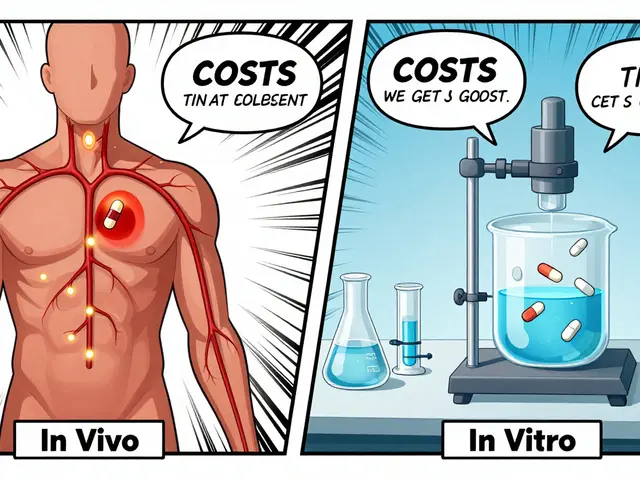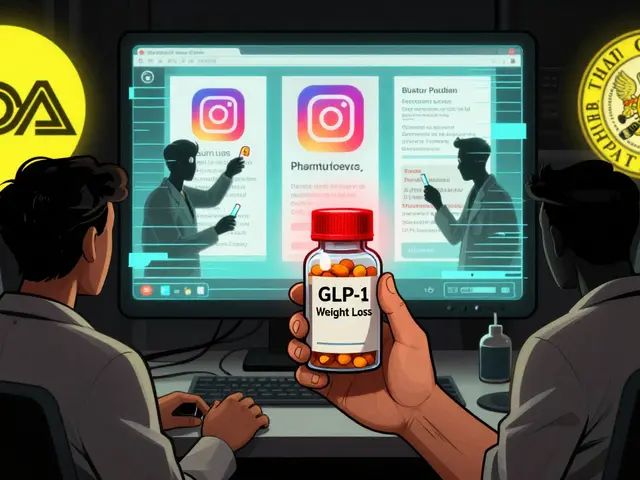
NSAID Selection Tool
Answer a few quick questions
Etodolac is a non‑steroidal anti‑inflammatory drug (NSAID) that primarily blocks the cyclooxygenase‑2 (COX‑2) enzyme, reducing inflammation and pain. Approved by the FDA in 1990, it’s usually prescribed for osteoarthritis, rheumatoid arthritis, and acute musculoskeletal injuries.
TL;DR - Quick Comparison
- Etodolac offers moderate COX‑2 selectivity with a half‑life of ~6hours.
- Ibuprofen and naproxen are non‑selective, inexpensive OTC options.
- Celecoxib is the most COX‑2‑selective prescription NSAID, but carries higher cardiovascular warnings.
- Diclofenac sits between non‑selective and selective, with strong GI risk.
- Choose based on your GI tolerance, heart health, dosing convenience, and need for prescription strength.
How Etodolac Works - The COX Story
All NSAIDs target cyclooxygenase enzymes that turn arachidonic acid into prostaglandins, the messengers that cause pain, fever, and swelling. There are two main isoforms:
COX‑1 is constitutively active, protecting the stomach lining and supporting platelet function.
COX‑2 is induced during inflammation, making it the primary culprit in pain pathways.
Etodolac preferentially inhibits COX‑2 (about 2‑3‑fold over COX‑1), which means it can relieve pain while sparing some gastric protection. The trade‑off is a modest increase in cardiovascular risk compared with pure COX‑1 blockers.
Key Attributes of Etodolac
- Typical oral dose: 300-600mg twice daily for arthritis; 400mg three times daily for acute pain.
- Half‑life: ~6hours, allowing twice‑daily dosing.
- FDA approval: 1990 (prescription‑only).
- GI risk: Lower than classic non‑selective NSAIDs but higher than placebo.
- Cardiovascular warning: Similar to other COX‑2‑biased agents; avoid in uncontrolled hypertension.
Common Alternatives - A Snapshot
When doctors or patients look for an Etodolac alternatives, they usually land on three families:
- Non‑selective NSAIDs - ibuprofen, naproxen, diclofenac.
- COX‑2‑selective agents - celecoxib.
- Hybrid or newer agents - meloxicam (moderate COX‑2 bias) - not covered in depth here but worth a mention.
Ibuprofen
Ibuprofen is an over‑the‑counter (OTC) NSAID that blocks both COX‑1 and COX‑2 equally, offering rapid relief for headaches, muscle aches, and mild arthritis.
- Typical dose: 200-400mg every 4‑6hours (max 1,200mg/day OTC).
- Half‑life: 2-4hours.
- GI risk: Moderate; higher with chronic use.
- Cardiovascular risk: Low to moderate; similar to placebo at OTC doses.
Naproxen
Naproxen is a longer‑acting non‑selective NSAID, often chosen for its 12‑hour dosing interval.
- Typical dose: 250-500mg twice daily.
- Half‑life: 12-15hours.
- GI risk: Slightly higher than ibuprofen for the same exposure.
- Cardiovascular risk: Generally low; naproxen has been studied for a neutral CV profile.
Diclofenac
Diclofenac sits between non‑selective and selective NSAIDs, with strong analgesic power but a notorious GI side‑effect profile.
- Typical dose: 50mg two to three times daily.
- Half‑life: 1-2hours (extended‑release forms last longer).
- GI risk: High; requires gastro‑protective co‑therapy in many patients.
- Cardiovascular risk: Elevated; FDA boxed warning.
Celecoxib
Celecoxib is a prescription‑only COX‑2‑selective NSAID that dramatically reduces stomach irritation but carries a black‑box warning for heart disease.
- Typical dose: 200mg once daily (or 100mg twice daily).
- Half‑life: 11hours.
- GI risk: Lowest among NSAIDs.
- Cardiovascular risk: Higher than non‑selective agents; avoid in patients with prior MI or stroke.

Side‑by‑Side Comparison Table
| Drug | FDA Approval (Year) | Half‑Life | COX Selectivity | Typical Prescription Dose | GI Risk | Cardiovascular Risk |
|---|---|---|---|---|---|---|
| Etodolac | 1990 | ~6h | COX‑2 biased (≈2‑3× COX‑1) | 300‑600mg BID | Moderate | Moderate |
| Ibuprofen | 1974 (OTC 1984) | 2‑4h | Non‑selective | 200‑400mg Q4‑6h | Low‑to‑moderate | Low‑to‑moderate |
| Naproxen | 1976 | 12‑15h | Non‑selective | 250‑500mg BID | Moderate | Low (neutral CV profile) |
| Diclofenac | 1978 | 1‑2h | Partial COX‑2 bias | 50mg TID | High | High |
| Celecoxib | 1998 | 11h | Highly COX‑2 selective | 200mg QD | Low | High |
Deciding Which NSAID Fits Your Situation
Choosing the right pain reliever isn’t about picking the “strongest” drug; it’s about balancing efficacy, safety, and convenience.
1. Gastro‑intestinal tolerance. If you’ve had ulcers or are on anticoagulants, a COX‑2‑selective option like celecoxib (or an ulcer‑protective regimen with a non‑selective NSAID) is smarter.
2. Cardiovascular health. Patients with a history of heart attack, stroke, or uncontrolled hypertension should steer clear of high‑risk agents such as diclofenac and celecoxib. Etodolac and naproxen are comparatively safer.
3. Dosing frequency. For people who dislike taking pills three times a day, Etodolac’s twice‑daily schedule or celecoxib’s once‑daily regimen beats ibuprofen’s four‑times‑daily need.
4. Prescription vs. OTC. If you need a quick, short‑term fix and have no major health warnings, ibuprofen or naproxen are readily available without a doctor’s note. Chronic conditions like rheumatoid arthritis often justify a prescription NSAID such as Etodolac.
5. Drug interactions. All NSAIDs can raise blood pressure and interact with ACE inhibitors, diuretics, or lithium. Etodolac has a modest interaction profile; diclofenac is notorious for affecting liver enzymes.
Practical Tips and Common Pitfalls
- Take NSAIDs with food or a full glass of milk to minimize stomach irritation.
- Never combine two NSAIDs simultaneously - the risk of GI bleeding spikes dramatically.
- Monitor blood pressure weekly if you’re on any NSAID for more than two weeks.
- If you need an NSAID after heart surgery, discuss celecoxib’s risks with your cardiologist.
- For athletes, naproxen’s longer half‑life may reduce dosing interruptions during training.
Related Concepts Worth Exploring
Understanding Etodolac in context opens doors to broader topics:
- Inflammatory pathways - how prostaglandins drive pain and fever.
- Pain management hierarchy - when to move from acetaminophen to NSAIDs to opioids.
- OTC vs. prescription regulation - what determines a drug’s availability.
- Gastro‑protective strategies - using proton‑pump inhibitors or misoprostol alongside NSAIDs.
- Cardiovascular safety monitoring - routine labs and imaging for high‑risk patients.
Next Steps for Readers
If you’re considering a switch from Etodolac to another NSAID, schedule a quick chat with your prescriber. Bring a list of current meds, any history of ulcers, and recent blood‑pressure readings. Ask specifically about dosing schedules that fit your daily routine - the right choice often hinges on convenience as much as chemistry.
For anyone new to NSAIDs, start with the lowest effective dose of an OTC option and only graduate to prescription agents if pain persists beyond a week. Keep a symptom diary; patterns often reveal whether inflammation or another issue is at play.

Frequently Asked Questions
Is Etodolac safer for the stomach than ibuprofen?
Etodolac is moderately COX‑2 biased, so it irritates the stomach less than a fully non‑selective NSAID like ibuprofen. However, it’s not ulcer‑proof; patients with a history of GI bleeding should still use a protective agent or choose a highly selective COX‑2 drug.
Can I take Etodolac and naproxen together for stronger pain relief?
No. Combining two NSAIDs dramatically raises the risk of stomach ulcers, kidney injury, and cardiovascular events. If one drug isn’t enough, talk to your doctor about switching agents or adding a different class of pain medication.
Which NSAID has the longest dosing interval?
Naproxen, with a half‑life of 12‑15hours, can be taken twice daily. Celecoxib also offers once‑daily dosing thanks to its 11‑hour half‑life and high COX‑2 selectivity.
What should I monitor while on any NSAID?
Check blood pressure weekly, watch for signs of stomach pain or black stools, and have your kidney function tested if you use NSAIDs for longer than a month. Anyone with heart disease should have a cardiology review before starting a high‑risk NSAID.
Is Etodolac available over the counter?
No. Etodolac requires a prescription in the United States because of its potency and the need for medical supervision regarding GI and cardiovascular safety.
20 Comments
Josie McManus
September 28, 2025 at 14:20 PM
i get it – you wanna kill the pain quick but dont want your stomach to scream. etodolac does a decent job, especially if you cant handle the gnarly ulcer risk of diclofenac. just make sure you tak it with food, dont be that guy who chugs it on an empty belly. also keep an eye on your bp, cuz it can nudge that up a bit. if you got a heart issue, maybe stick with naproxen instead.
Heather Kennedy
October 2, 2025 at 18:20 PM
From a pharmacokinetic perspective, Etodolac’s half‑life approximates six hours, enabling a BID dosing schema. Its COX‑2 selectivity ratio hovers around 2–3:1, which mitigates gastric mucosal disruption relative to non‑selective agents. Nonetheless, the drug retains sufficient platelet inhibition to warrant caution in anticoagulated cohorts. Comparative efficacy trials suggest parity with Ibuprofen for acute nociceptive pain, albeit with a marginally better GI profile. Clinical decision‑making should therefore integrate comorbidity indices.
Janice Rodrigiez
October 6, 2025 at 22:20 PM
Etodolac is a solid middle‑ground option – better on the stomach than ibuprofen but not as risky for the heart as some others. It’s great if you need something prescription‑only and you don’t want to pop pills every few hours. Just remember to take it with food and watch your blood pressure.
Roger Cardoso
October 11, 2025 at 02:20 AM
They want you to believe the FDA “approved” Etodolac in 1990, but no one tells you about the hidden data on cardiovascular events that were quietly buried. The whole COX‑2 bias narrative is a PR stunt to keep the big pharma profits rolling while you think you’re safe. If you’re truly looking for a painkiller that doesn’t sabotage your heart, look beyond the tables they hand you.
barry conpoes
October 15, 2025 at 06:20 AM
Look, folks, American manufacturers have been pushing Etodolac as the go‑to NSAID for our troops because it balances efficacy and safety without the overseas price tags you see on celecoxib. It’s prescription‑only for a reason – we need doctors to keep tabs on usage, not let everybody self‑medicate like it’s a commodity. Support domestic pharma, use Etodolac responsibly.
justin davis
October 19, 2025 at 10:20 AM
Wow!!! Another NSAID showdown!!! Who would've thought anyone cared about COX‑2 versus COX‑1??? Etodolac struts onto the stage, twirling its “moderate selectivity” badge like it’s the superhero of pain relief!!! Meanwhile, ibuprofen is still stuck in the “cheap and happy” corner!!!
David Lance Saxon Jr.
October 23, 2025 at 14:20 PM
The ontological implication of selecting an NSAID transcends mere symptom attenuation; it is an act of existential alignment with one's physiological narratives. Etodolac, positioned within the pharmacodynamic spectrum as a COX‑2‑biased entity, invites the patient to negotiate the dialectic of inflammation versus homeostatic preservation. By juxtaposing its half‑life and receptor affinity against the archetype of non‑selective agents, one discerns a subtle hierarchy of therapeutic agency. Embrace the nuance, lest you succumb to reductive analgesic dogma.
Moore Lauren
October 27, 2025 at 17:20 PM
Take Etodolac with a meal, monitor blood pressure, and avoid combining it with other NSAIDs. If stomach issues arise, consider a PPI.
Jonathan Seanston
October 31, 2025 at 21:20 PM
Good points! Mixing NSAIDs really does up the risk, so sticking to one is wise.
Sukanya Borborah
November 5, 2025 at 01:20 AM
Honestly, this article could have been half the length. The table formatting is clunky, and the repeated “GI risk” bullet points feel redundant. Also, “COX‑2 biased (≈2‑3× COX‑1)” – why not just say “moderate COX‑2 selectivity”? Minor grammar slips here and there, but overall it’s passable.
bruce hain
November 9, 2025 at 05:20 AM
Etodolac sits awkwardly between ibuprofen and celecoxib.
Stu Davies
November 13, 2025 at 09:20 AM
I totally get the confusion – navigating NSAIDs feels like a maze 😅. Just remember, the stomach is your best friend, so protect it! 👍
Nadia Stallaert
November 17, 2025 at 13:20 PM
When you delve into the labyrinthine world of NSAID pharmacology, you quickly discover that Etodolac is neither a hero nor a villain, but rather a complex protagonist in a narrative fraught with trade‑offs; its COX‑2 bias confers a modest gastric advantage, yet this same bias whispers ominously of cardiovascular peril-a dichotomy that mirrors the very duality of human nature itself!!! The half‑life of roughly six hours offers a dosing schedule that some patients find convenient, but others lament the need for twice‑daily administration, especially when compared to naproxen's once‑daily ease! Moreover, the drug's prescription‑only status in the United States adds an extra layer of gatekeeping, ensuring that a clinician can assess comorbidities-yet it also creates barriers for those without insurance, prompting a cascade of inequities in pain management!!! From a mechanistic standpoint, Etodolac's inhibition of prostaglandin synthesis curtails inflammation, but the downstream effects on platelet function cannot be ignored, particularly in patients on anticoagulants, where even a modest increase in bleeding risk can tip the scales toward disaster!!! In the grand tapestry of therapeutic options, the choice between Etodolac, ibuprofen, naproxen, diclofenac, and celecoxib becomes a strategic decision matrix, where variables such as gastrointestinal tolerance, cardiovascular history, dosing frequency preference, and cost intersect in a multidimensional space!!! Some clinicians champion the use of Etodolac for its balanced profile, while others shy away, favoring the more established safety data of ibuprofen or the gastric sparing of celecoxib, despite its own cardiac concerns!!! It is also worth noting that drug‑drug interactions, such as with ACE inhibitors or lithium, can amplify adverse effects, demanding vigilant monitoring!!! Patients should be educated about the signs of gastrointestinal bleeding-black stools, abdominal pain, or unexplained anemia-because early detection can prevent catastrophic outcomes!!! Simultaneously, regular blood pressure checks become essential, given the drug’s potential to elevate systemic pressure in susceptible individuals!!! The literature also hints at a modest risk of renal impairment, particularly in the elderly or those with pre‑existing kidney disease, underscoring the necessity of dose adjustments or alternative therapies!!! Ultimately, the decision to prescribe Etodolac hinges upon a nuanced risk‑benefit assessment, tailored to the individual’s clinical portrait, and should never be a one‑size‑fits‑all proclamation!!! Therefore, engage in shared decision‑making, weigh the empirical evidence, and align the therapeutic plan with the patient’s values and lifestyle preferences!!! In summary, Etodolac occupies a middle ground that demands careful contemplation, not hasty adoption.
Greg RipKid
November 21, 2025 at 17:20 PM
Sounds like a solid rundown; I’ll keep those points in mind when I need something stronger than ibuprofen but don’t want a prescription.
John Price Hannah
November 25, 2025 at 21:20 PM
Holy moly!!! That paragraph just turned my brain into a spaghetti of clinical jargon and existential dread!!! I love how you juxtaposed the “hero vs villain” trope with pharmacodynamics – truly a masterpiece of medical poetry!!!
Echo Rosales
November 30, 2025 at 01:20 AM
While the conspiratorial angle is entertaining, the data on Etodolac’s cardiovascular profile is fairly robust when examined in peer‑reviewed meta‑analyses.
Elle McNair
December 4, 2025 at 05:20 AM
Agree, it’s a middle ground.
Dennis Owiti
December 8, 2025 at 09:20 AM
Thx for the empthy advice! I’ll try to keep my stomach happy and not overdos.
Justin Durden
December 12, 2025 at 13:20 PM
Good job staying on track, keep monitoring your BP and stay in touch with your doc.






Steve Smilie
September 24, 2025 at 10:20 AM
Ah, the subtle art of NSAID selection-one must wade through a morass of pharmacodynamic nuance! Etodolac, with its modest COX‑2 bias, straddles the line between gastric safety and cardiovascular caution. If you’re a patient plagued by arthritic flare‑ups yet wary of ulcerogenicity, its twice‑daily regimen offers a compromise. Compare that to Ibuprofen’s four‑times‑daily hustle, and you’ll appreciate the elegance of a more measured dosing schedule. Of course, the clinician’s judgment remains the ultimate arbiter.